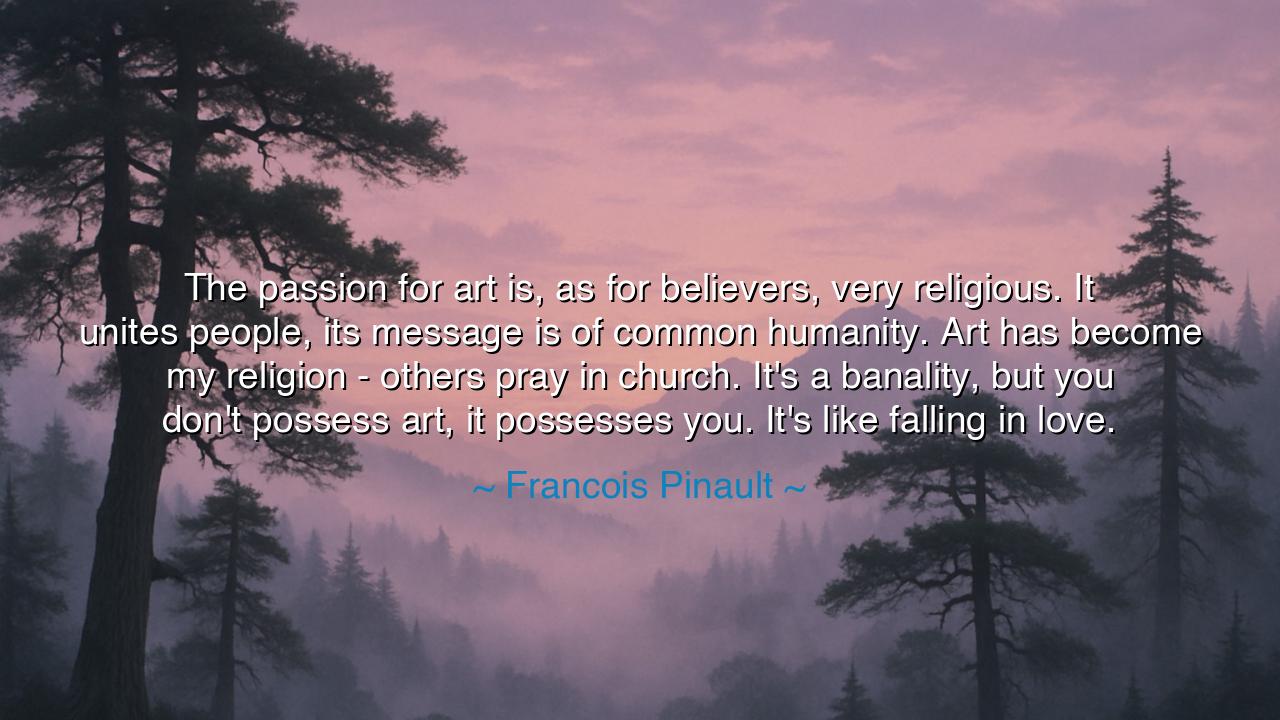
The passion for art is, as for believers, very religious. It
The passion for art is, as for believers, very religious. It unites people, its message is of common humanity. Art has become my religion - others pray in church. It's a banality, but you don't possess art, it possesses you. It's like falling in love.






Hear now the words of François Pinault, a man who gave his heart to beauty and found in it a kind of salvation: “The passion for art is, as for believers, very religious. It unites people, its message is of common humanity. Art has become my religion – others pray in church. It's a banality, but you don't possess art, it possesses you. It's like falling in love.” These words, though spoken by a collector of masterpieces, carry the wisdom of the ancients, for they remind us that art, like religion, is not merely seen or held, but lived, felt, and surrendered to.
For what is art if not the song of the soul expressed in color, form, and sound? It transcends language, culture, and creed. A painting from centuries past, though born of another land and tongue, may move the heart of one who knows nothing of its origins. Just as the devout kneel in temples and find themselves bound to the eternal, so too does the lover of art bow in reverence before beauty, sensing within it a message of common humanity. In this way, art becomes a universal faith, one that unites not by doctrine, but by shared wonder.
Consider the story of the Sistine Chapel, where Michelangelo, with aching hands and eyes turned heavenward, painted the ceiling that still astonishes the world. When pilgrims enter that place, whether believer or skeptic, they are struck silent, as though in prayer. The images of creation and judgment speak not only to Catholic faith but to the very longing of mankind for meaning, destiny, and connection with the divine. This is what Pinault means when he says art “possesses you”—for standing beneath that ceiling, you are not the master of beauty; beauty masters you.
And yet, the power of art lies not only in the grand and exalted but also in the simple. A folk song sung by peasants in the fields, a pot shaped by the hand of an unknown craftsman, a mural painted on the wall of a war-torn city—these too are sacred. They carry the weight of humanity’s joys and sorrows, of love and loss. They remind us that the religion of art is not only for kings and collectors, but for all who live, for it speaks in the language of life itself.
Pinault’s words also reveal a truth about the nature of devotion: you do not possess art, it possesses you. This is the humility of the true believer, whether in faith or in beauty. The proud may think they own a masterpiece because it hangs on their wall, but the wise know the reverse is true: the art owns them, commanding their gaze, shaping their thoughts, awakening their emotions. Just as a lover is not master of love but its servant, so too the devotee of art is carried away, filled with a fire not of his own making.
And so the lesson emerges: cultivate within yourself a reverence for beauty, for in doing so you draw nearer to the essence of humanity. Let art be your teacher, whether you find it in a painting, a song, a poem, or the silent sculpture of the mountains and seas. Do not seek to control it, but allow it to move you, to enlarge your soul, to connect you with others. In a world too often divided by creed and nation, art is the universal church, where all may kneel together in awe.
So I say to you, O travelers of time: pursue art not as an ornament, but as a path. Let it remind you of your shared humanity, let it lift you beyond selfishness, let it teach you to feel deeply. For as François Pinault declared, art is like falling in love: it sweeps you into its arms, it transforms your being, and it leaves you with the sacred knowledge that, in beauty, all souls are one.






AAdministratorAdministrator
Welcome, honored guests. Please leave a comment, we will respond soon